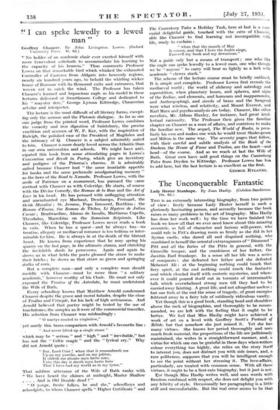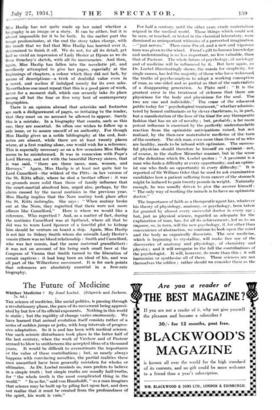The Unconquerable Fantastic THIS is an extremely interesting biography, from
two points of view : firstly because Lady Hester herself is such a gloriously fascinating person, and secondly because the book raises so many problems in the art of biography. Miss Haslip has done her work well : by the time we have finished the book we know all that we ever need know about this amazing eccentric, so full of character and furious will-power, who could rule in Pitt's drawing room as firmly as she did in her Syrian castle, who dared all and disguised nothing, who combined in herself the oriental extravagances of " Diamond " Pitt and all the furies of the Pitts in general, with the Grenville temper, and the crankiness of her father, the Jacobin Earl Stanhope. In a sense all her life was a series of conquests : she defeated her father and she defeated Mehemet Ali : at the beginning nothing could touch that fiery spirit, at the end nothing could reach the fantastic soul which clouded itself with esoteric mysteries, and when- ever it could poured itself out in torrents of interminable talk which overwhelmed strong men till they had to be carried away fainting. A great life, and not altogether useless ; but one feels at the end the sense of tragedy, of great energies frittered away in a fairy tale of sublimely ridiculous vanity.
Yet though this is a good book, standing head and shoulders above the ruck of biographies, and thoroughly to be recom- mended, we are left with the feeling that it ought to be better. We feel that Miss Haslip might have achieved a work of art on a level with Geoffrey Scott's Portrait of &gide, but that somehow she just missed it. Yet she has many virtues. She knows her -period thoroughly and uses much fresh material, the proportions of the life are judiciously maintained, she writes in a straightforward manner, and, a virtue for which one can be grateful in these days when writers colour everything too highly, she relies on the story itself to interest you, does not distract you with side issues, and, a rare politeness, supposes that you will be intelligent enough to see the point without her stressing it. The love-affairs, particularly, are treated with common sense. With all these virtues, it ought to be a first-rate biography, but it just is not.
gor though Miss Haslip writes well, and uses words with freedom combined with respect, she does not delight you with any felicity of style. Occasionally her paragraphing is a little stiff and uncomfortable. But the real error seems to be that Miss Haslip has not quite made up her mind whether a biography is an image or a story. It can be either, but it is almost impossible for it to be both. In the earlier part the image predominates, at the end the story takes charge, with the result that we feel that Miss Haslip has hurried over it, determined to finish it off. We do not, for all its detail, get half so vivid an impression of Lady Hester at Djoun as we do from Strachey's sketch, with all its inaccuracies. And then, again, Miss Haslip has fallen into the novelistic pit, and needlessly attempted to give her pages, especially at the beginnings of chapters, a colour which they did not lack., by means of descriptions—a trick of doubtful value even in a novel, and useless if indulged merely for its own sake. Nevertheless one must repeat that this is a good piece of work, never for a moment dull, which can securely take its place among all but the four or five very best of contemporary biographies.
There is an opinion abroad that asterisks and footnotes are such a disfigurement of pages, so irritating to the reader, that they must on no account be allowed to appear. Surely this is a mistake.. In a biography that counts, such as this one, they are essential. So often one wishes to follow up a side issue, or to assure oneself of an authority. For though Miss Haslip gives us a noble bibliography at the end, foot- notes are absent, while there are at least twenty places where, at a first reading alone, one would wish for a reference. This is especially necessary as on a few occasions Miss Haslip seems to be misinformed. It was in connexion with Pope's Lord Hervey, and not with the beautiful Hervey sisters, that it was said, " there are three races, men, women, and Herveys." Again, Miss Haslip is at least not quite fair to Lord Camelford—the wildest of the Pitts—in her version of the St. Kitts affair, where he shot a brother officer : it was on grounds more solid than those of family influence that the court-martial absolved him, urged also, perhaps, by the alarm caused by the naval mutinies in the previous year. Miss Haslip implies that the Nore mutiny took place after the St. Kitts imbroglio. She says : " When mutiny broke out at the Nore, they regretted that there were not more officers like Camelford." Here is where we would like a reference. Who regretted ? And, as a matter of fact, during the mutinies Camelford was at Spithead, where all that he did was to warn Lord Spencer of a fanciful plot to kidnap him should he venture on board a ship. Again, Miss Haslip is not fair to Sidney Smith whom she miscalls Lady Hester's cousin (there was no blood relationship : Smith and Camelford, who was her cousin, had the same maternal grandfather) : it was not on account of his being such small beer at the Congress of Vienna that Smith turned to the liberation of corsair captives : it had long been an ideal of his, and was all part of the Wilberforce movement. It is for such points that references are absolutely essential in a first-rate biography.



































 Previous page
Previous page